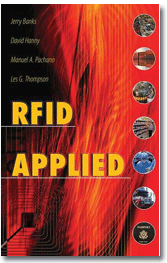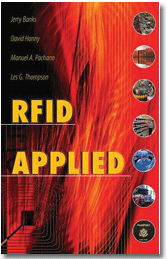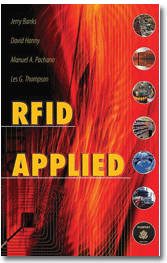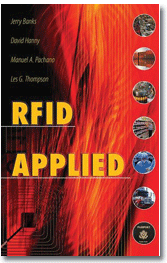Understanding RFID Part 3: Passive Tags
13 June, 2007
category: Government, RFID
 By Jerry Banks and Les G. Thompson, co-authors of RFID Applied
By Jerry Banks and Les G. Thompson, co-authors of RFID Applied
In the previous article, “The principles of RFID: Active Tags,” we discussed a classification of RFID tag called the active tag. Even though the active tag has many applications, it does not get as much press as its sister, the passive tag. It isn’t hard to understand why this is the case. Passive tags are the darling of the retail industry and the U.S. Department of Defense (DoD) because they are cheaper than active tags and disposable. Passive tags cost less because they do not require a battery to operate and are generally less expensive to manufacture. The most inexpensive passive tag is used in electronic article surveillance (EAS) systems. EAS tags are found in books, attached to clothes, and sealed inside DVD and compact disc cases, among many other applications. These types of tags only transmit an “I am here” signal when they are activated. They do not have the unique identifier that is usually associated with RFID technology but they do discourage would be shoplifters.
The EPC specification classifies passive tags as Classes 0 through 3 because they communicate via a method called backscattering. EPC Class 3 tags do have an onboard battery, but the battery is not used for active transmission. The battery is only used to power the tag’s circuitry and any onboard sensors or peripherals. Class 3 tags are also known as semi-passive tags. The vast majority of passive tags on the market today are the second generation EPC Class 1 tags.
Basics of passive tagging
Passive tags do not require a battery to operate because they can extract energy from the electro-magnetic radiation with which they come in contact. In 1948, Harry Stockman discovered that radio waves can be used to power a remote transmitter. This is the principle of operation for passive tags. Passive tag manufacturers design their tags to be efficient energy collectors. This requires the manufacturers to become very creative with the antenna designs that they attach to the tag’s central processing circuitry. The antenna is the key component in the physics behind how energy is collected from the electro-magnetic radiation generated by the antenna connected to a reader. This interaction between the tag and the reader’s antenna is also known as coupling. Our next article will delve into the details of different antenna types and configurations. For now, it is important to know that the antenna is a key component in the function of the passive tag.
 Most passive tags use a method called backscattering to communicate with the reader. Backscattering refers to the way in which the tag communicates with the reader through a carrier wave that originated from the reader’s antenna. The tag “tugs” on the carrier wave to create minute fluctuations in the wave’s amplitude. The amplitude changes are used to encode digital information to transmit to the reader. The reader must be able to detect these tiny changes while, at the same time, provide enough energy to power the tag. Backscattering works much like a transformer does except that it occurs in free space. The reader and tag play the parts of two coils in the transformer. As the tag shunts the coil through a transistor, the reader’s side will detect a tiny drop in voltage. The tag simply shunts the coil to encode the data that is to be transmitted.
Most passive tags use a method called backscattering to communicate with the reader. Backscattering refers to the way in which the tag communicates with the reader through a carrier wave that originated from the reader’s antenna. The tag “tugs” on the carrier wave to create minute fluctuations in the wave’s amplitude. The amplitude changes are used to encode digital information to transmit to the reader. The reader must be able to detect these tiny changes while, at the same time, provide enough energy to power the tag. Backscattering works much like a transformer does except that it occurs in free space. The reader and tag play the parts of two coils in the transformer. As the tag shunts the coil through a transistor, the reader’s side will detect a tiny drop in voltage. The tag simply shunts the coil to encode the data that is to be transmitted.
Passive tags can be purchased in many different form factors. The naked tag is called the inlay consisting of the integrated circuit and antenna only. Usually, the inlay is deposited onto a substrate using a chemical process (but, not electroplated). The substrate can be paper, polystyrene, or some other material. Most “slap and ship” RFID tags are nothing more than the inlay in a paper envelope. The paper provides some protection and is ideal for tags that have a short life expectancy. The paper is usually printed with a barcode that contains the RFID tag’s unique identifier so that the item can be identified with an RFID reader, barcode scanner, or by simply reading the number printed below the barcode. If a more durable passive tag is required, the tag may be encased in rubber or enclosed in plastic.
Passive RFID tags come in a wide range of sizes. Some tags’ dimensions may be measured in millimeters while others could be measured in feet. The selection of antenna affects the size of the tag. Larger antennas allow tags to be read at a greater distance.
Once the passive tag is powered and the coupling between the tag and reader has occurred, the transponder, the tag, and the reader, can now have a conversation as long as the tag stays in close enough proximity to the reader. The conversation that the two components have is known as the air interface protocol. There are several organizations that are in the process of standardizing RFID protocols. Some of the more notable standards organizations are GS1/GS1 US and the International Organization for Standardization (ISO). Many of these organizations work closely with each other so their standards are compatible at some level. In fact, it is not uncommon for these organizations’ members to actively participate in more than one standards organization. Some tag standards of interest are the ISO 18000 series of air interface standards. The ISO 18000 series also includes amendments that ratify other standards such as EPC Class 1 Generation 2 (ISO 18000-6C) air interface protocol.
Key commands for passive tags
No matter which standard the tag implements there are some basic commands that all passive tags must implement to be effective. Readers must be able to control the tag population in an organized manner. If all tags transmitted at the same time and without any order, the reader may never be able to receive a single uninterrupted transmission from a tag when the tag population is high. Tags are usually selected by the reader and given directions on when they are allowed to transmit. The EPC standard refers to a Q value which represents a seed number used to select subsets of the tag’s population for interrogation. Other protocols have other methods to reach the same end.
 Once a tag has been selected, the reader must be able to read the data from the tag. If the tag has onboard memory, the reader can request that the tag transmit a certain number of bytes from a given address in the tag’s memory. Some tags do not have extra memory, so they only transmit their unique identifier. Some protocols have access restrictions for different address regions in the tag. To access these restricted regions, the reader must authenticate with the tag. Authentication may be associated with only certain commands, or may be required of them all.
Once a tag has been selected, the reader must be able to read the data from the tag. If the tag has onboard memory, the reader can request that the tag transmit a certain number of bytes from a given address in the tag’s memory. Some tags do not have extra memory, so they only transmit their unique identifier. Some protocols have access restrictions for different address regions in the tag. To access these restricted regions, the reader must authenticate with the tag. Authentication may be associated with only certain commands, or may be required of them all.
Some tags allow readers to write to the tag’s onboard memory. If the tag supports writing, the reader transmits the starting memory address, the number of bytes to write, and the data to write beginning with the starting memory address.
The ‘kill’ command can be issued by the reader to stop the tag from ever transmitting again. This command usually has multiple parts because the tag manufacturers want to make sure that the request to kill the tag is deliberate. These are the basic types of commands that can be found in most standardized air interface protocols.
Interrogating tags in real world environments
The deployment of a solution using passive tags has some interesting considerations. As mentioned in our first article, passive tag antennas are usually set up in a portal type configuration. In this configuration reader antennas are placed on each side of the path through which a tag may travel. In loading dock scenarios, the antennas may be placed above and/or below the path in addition to the sides. This configuration ensures that no matter which way the tag is oriented, there will most likely be an antenna that can power it. In some cases, tags at the very center of a palette or container of goods may not be able to receive enough energy from the antennas in any configuration.
Misreads may require changes in how and when the RFID tags are interrogated. Most RFID enabled systems with these types of issues require the tag to be read at multiple locations and in different configurations. For example, an attempt may be made to read all the tags in a container when the container is taken off of the truck, and a second attempt is made when the container is unpacked. If there are boxes in the container, a third attempt may be made when the items are removed from each box. When these interrogation attempts are correctly integrated into the inventory process, it is possible to obtain almost 100% read rates using passive tag technology.
Assembly lines have an added advantage because they can control the orientation of the tag and placement of the tag on the goods being tracked. Real time location systems (RTLSs) place portals at each entry and exit way into a zone that is to be tracked. As tags move in and out of these portals, the system can assume the tag’s current physical location.
Passive tag prices have not yet reached the US$0.05 per tag goal set by the retail industry, but there is still a great return on investment based on today’s prices. We may not be able to tag every can of soup, but container and pallet tagging is a valid goal with real monetary rewards.
This article is the third in an ongoing series that will explain the principles of RFID. It was created for RFIDNews by Jerry Banks, Independent Consultant, Atlanta Georgia and Les G. Thompson, Lost Recovery Network, Inc., Atlanta, Georgia. The authors are two of four co-authors of RFID Applied, John Wiley, 2007, ISBN-10 0471793655; ISBN-13 978-041793656.




